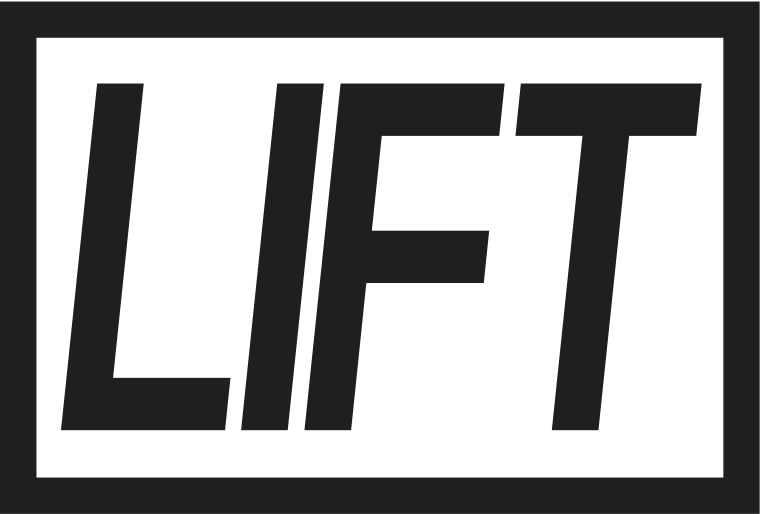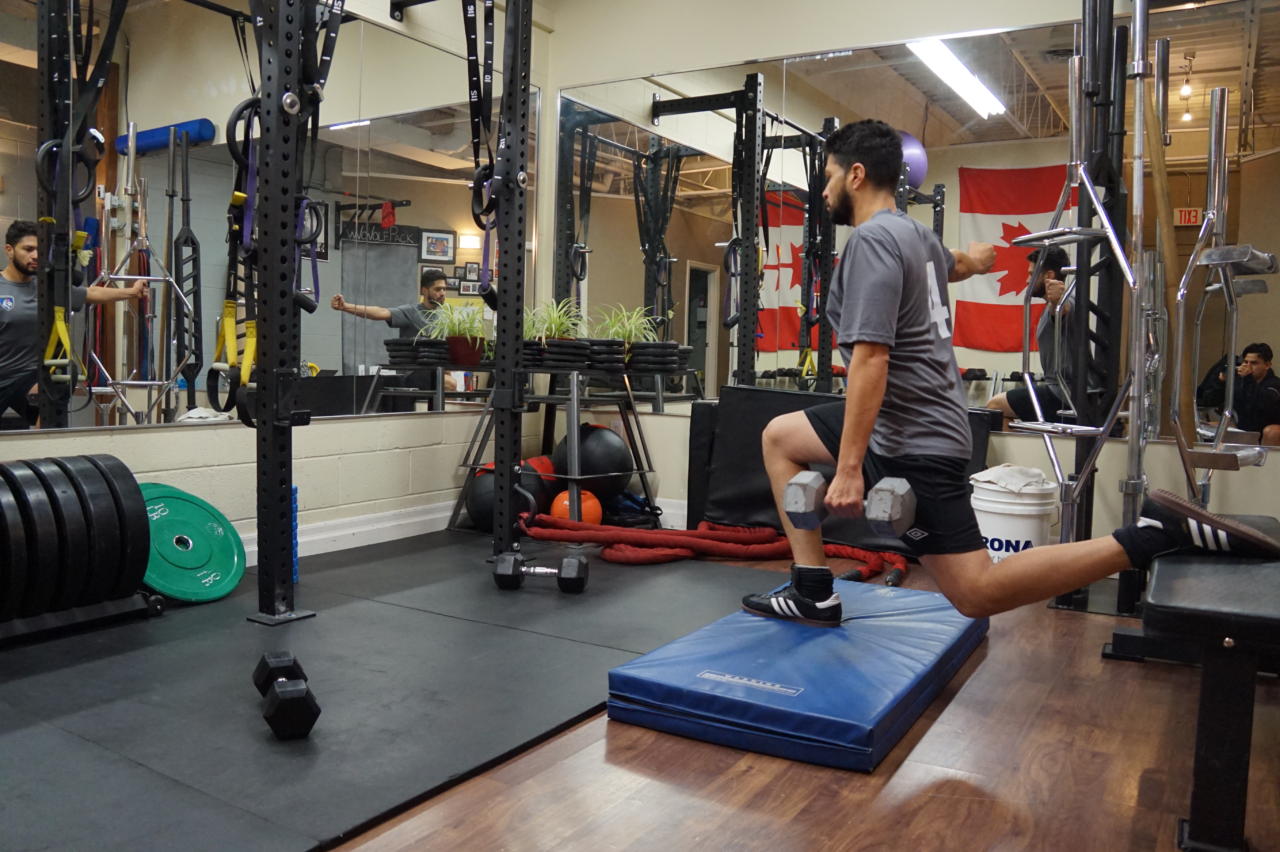I remember seeing a guy at the Western Rec Centre who slowly lifted his shorts and flexed his quads in front of the gym mirror. He shook his head in disappointment, and proceeded to squat more. I thought it was hilarious and still think about it from time to time. I hope that guy is doing alright now.
Squatting, and just lower body exercises in general, are great for various reasons! You think more people would prioritize training their lower bodies to maintain strong and mobile legs as they age, but that’s not so much the case. From an athletic point of view, having strong well functioning legs gives you the extra edge when you’re trying to run by someone. And from a vain perspective, having nice looking legs is definitely a big bonus. Strong well-defined legs can be accomplished using many different exercises and variations, but we’ll go over squatting in particular in this post.
How To Squat
Watch a baby squat and they’ll do it with perfect form. Ass to grass. But somewhere in between being a fun baby and a boring mid 20s-40s office working adult, we forget how to squat.
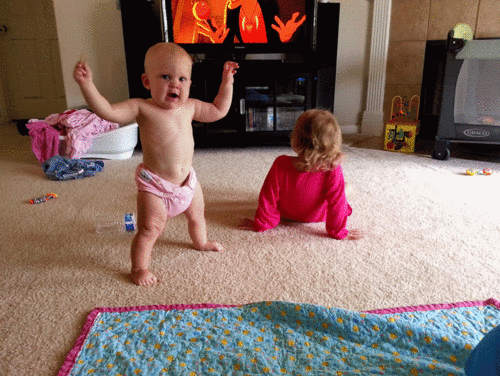 How you squat may differ from how your best friend squats. This is because of previous injuries, hip anatomy, shoulder tightness, potential lower back problems, etc. When you take a weekend personal training certification, which is nowhere near long enough, you get a booklet that outlines different exercises. During the practical, assuming your certification does that; you tell the instructor how you would coach a squat. It’s best to repeat verbatim what was said in the book. The problem with these books and courses is that it assumes everyone has the same anatomy, injuries, femur length, shoulder mobility, etc. The reality is that a different hip anatomy means a different squat stance and flair angle. Different injuries and fitness abilities may also mean you start off with a TRX squat or split squat before going onto a goblet squat, let alone a barbell back squat.
How you squat may differ from how your best friend squats. This is because of previous injuries, hip anatomy, shoulder tightness, potential lower back problems, etc. When you take a weekend personal training certification, which is nowhere near long enough, you get a booklet that outlines different exercises. During the practical, assuming your certification does that; you tell the instructor how you would coach a squat. It’s best to repeat verbatim what was said in the book. The problem with these books and courses is that it assumes everyone has the same anatomy, injuries, femur length, shoulder mobility, etc. The reality is that a different hip anatomy means a different squat stance and flair angle. Different injuries and fitness abilities may also mean you start off with a TRX squat or split squat before going onto a goblet squat, let alone a barbell back squat.
So it’s best to play around with different foot positions (generally 15-30% degrees) and squat stances to see what allows you to get greater depth. Stay tight with the upper body regardless of the variation you are doing. This video by the Lower Back God Stuart McGill is a great way to figure out your ideal squat stance.
Once you have your stance, drive your feet into the floor and keep them glued there. You will generate a lot more force and use more of your leg muscles when you keep your entire foot corkscrewed to the floor. Break at the hips (hips go back) and the knees (knees go forward) simultaneously and descend while keeping your spine in a “neutral” position. You can think of dropping your torso in between your legs so that your elbows end up inside your knees, when learning a body weight or goblet squat. Aim for parallel depth with your legs assuming it’s not causing you pain.
Once at the bottom, drive into your feet to go back up and finish the motion at the top by squeezing your glutes. Keep the weight distribution over the mid foot so that your torso doesn’t fall forward or backward, and squat in a controlled fashion.
Common Squatting Errors – As Seen At Big Box Gyms
Hunching or Hyperextending The Back
Keep the core tense and engaged. Get your abs (ribcage) down before you start your squat. If you’re having troubles keeping braced then imagine someone is about to punch you as you’re squatting down . Prevent the upper back from hunching by keeping a proud chest throughout the movement. You want a neutral spine when squatting or very slight natural arch. If you start feeling your lower back when you push your chest up, then you’re over doing it with the “chest up” cue, and most likely hyperextending your back.
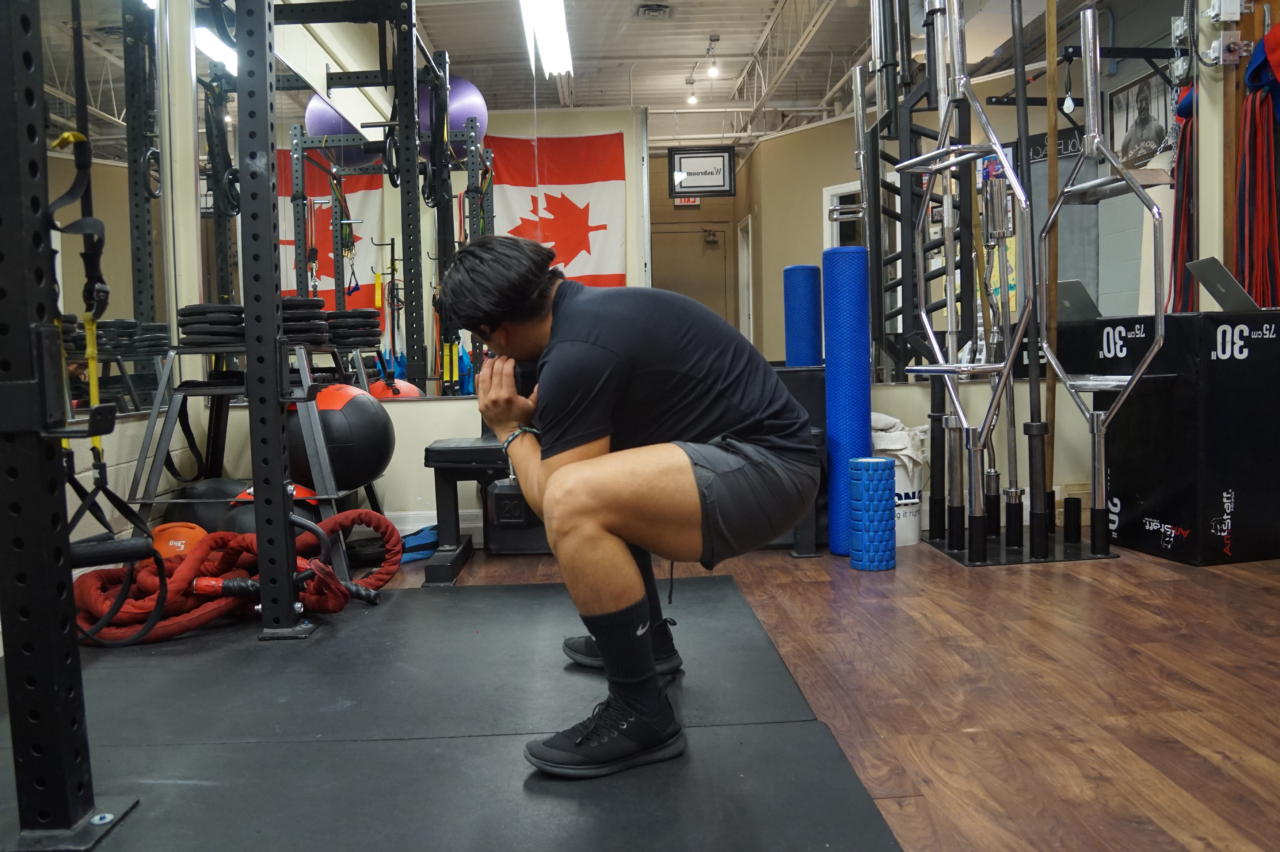
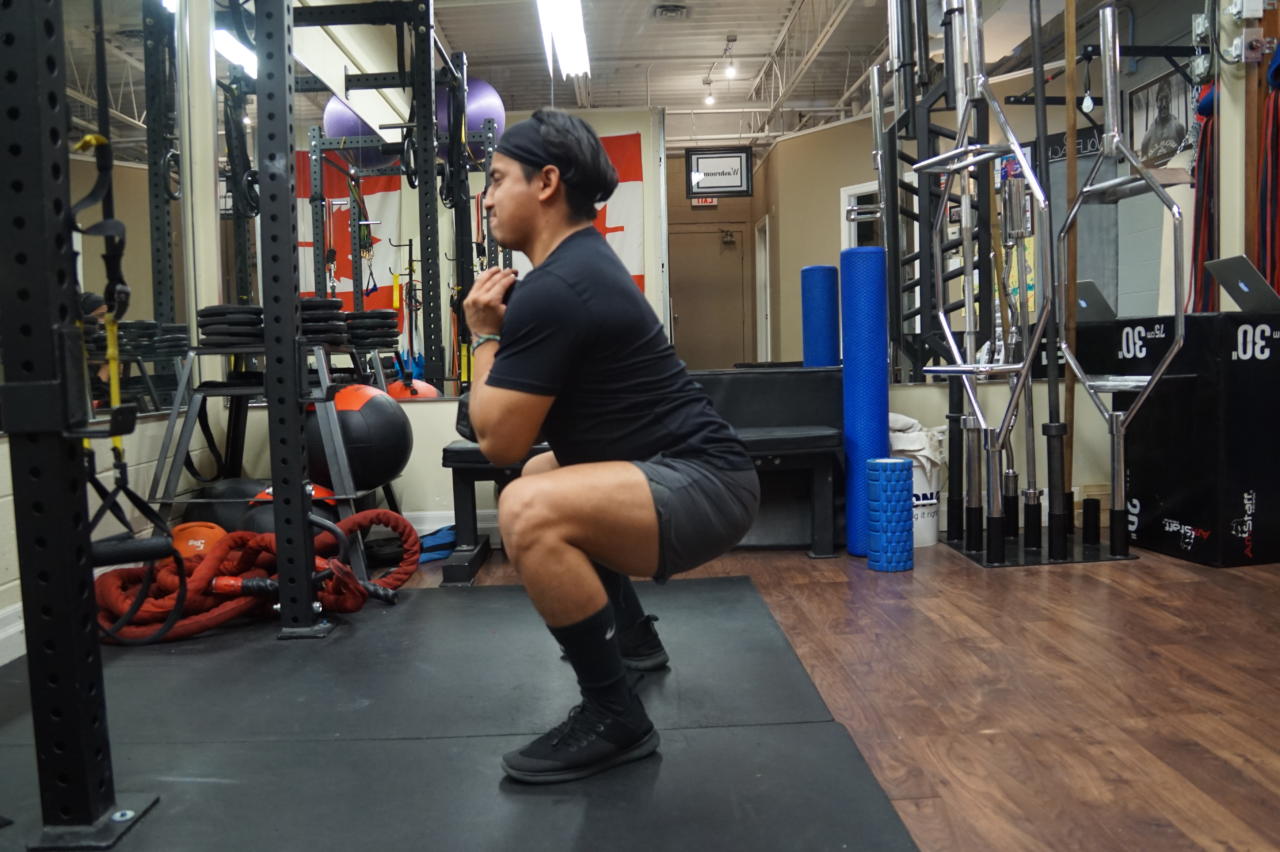
Knee Collapse
Knee valgus, which refers to the knees collapsing inwards, can happen for a variety of reasons. It could be as simple as a technique issue. This can be corrected by cork screwing your feet into the floor which creates tension in the outside of the hips. Keep this tension throughout to let the joints naturally push out while keeping your whole foot glued to the floor. It could also be because of weak glutes which relates to the first point about technique. Try incorporating band exercises that works the glute medius such as band walks, band squats, and band abduction variations. Knee collapse can also occur because of a lack of ankle mobility. Squatting, especially when squatting low, requires a lot of ankle dorsiflexion. See the “ankle collapse” section below.
Ankle Collapse
If you’re missing some ankle mobility, then your knees may eventually collapse in order to compensate for the lack of ankle mobility. No biggie though! This is usually taken care of with some self myofascial release (SMR) on the calves and feet, plus some ankle mobility drills. Try widening your stance a bit too so that the ankles don’t collapse. You can also squat with wedges or weights underneath your heel, which will give you more ankle mobility and greater depth while squatting.
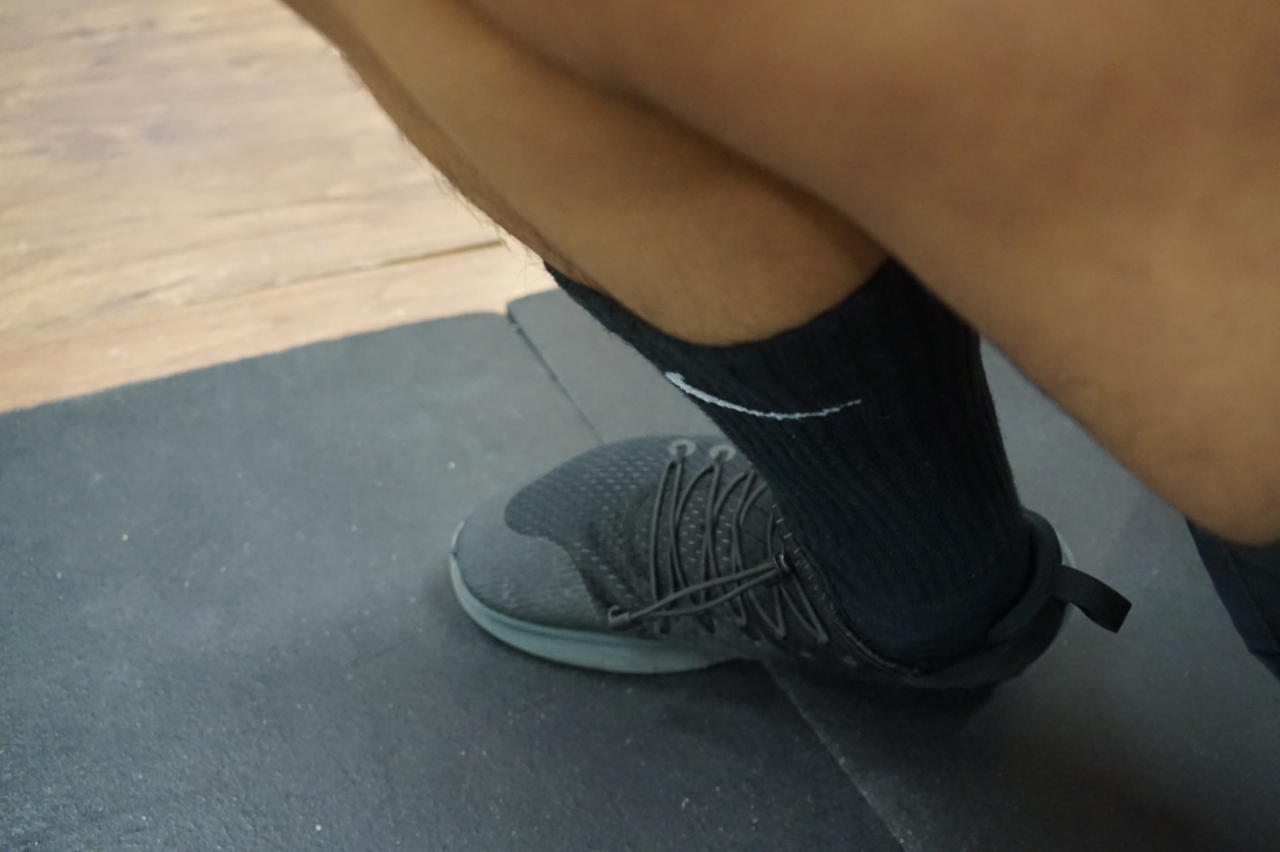
Balance
Keep your upper body tense when you’re doing a lower body exercise to prevent any shakiness or falls. Make two fists as hard as you can. Imagine you’re trying to crush someone or something you dislike. Stiffen your lats and core by pretending to squeeze oranges in your armpits for greater total upper body tightness. This helps with squats, lunges, split squats, and Bulgarian split squats. You can also try doing box squats as it gives you better proprioception. And if you do find your balance is still off then use equipment for balance, such as a TRX. Master the movement with a TRX or some sort of assistance before moving onto body weight.
Breathing
A lot of people tend to breathe through their chest and upper traps. We want to focus more on diaphragmatic breathing aka belly breathing to create greater intra-abdominal pressure. This will give your lower back greater protection and stability. You want to think about breathing into your belly, or diaphragm, from a global perspective. This means we’ll be expanding from the front, side, and the back of the torso. Just like a belt. Do this and you will engage your core and protect your lower back, especially if you plan on lifting heavy weight.
Squatting On Your Toes
You want to ground your feet into the floor. This means the heel, mid foot, and the toes. Keep the weight distribution in the middle. Squatting and pushing up from your toes puts greater stress on the knees and more emphasis on the quads. You cannot fully engage your posterior chain when squatting through your toes which means you’re missing out on some serious power. Get a good grip with your feet on the floor and drive though your feet! This will allow you to create more force and therefore more power when squatting.
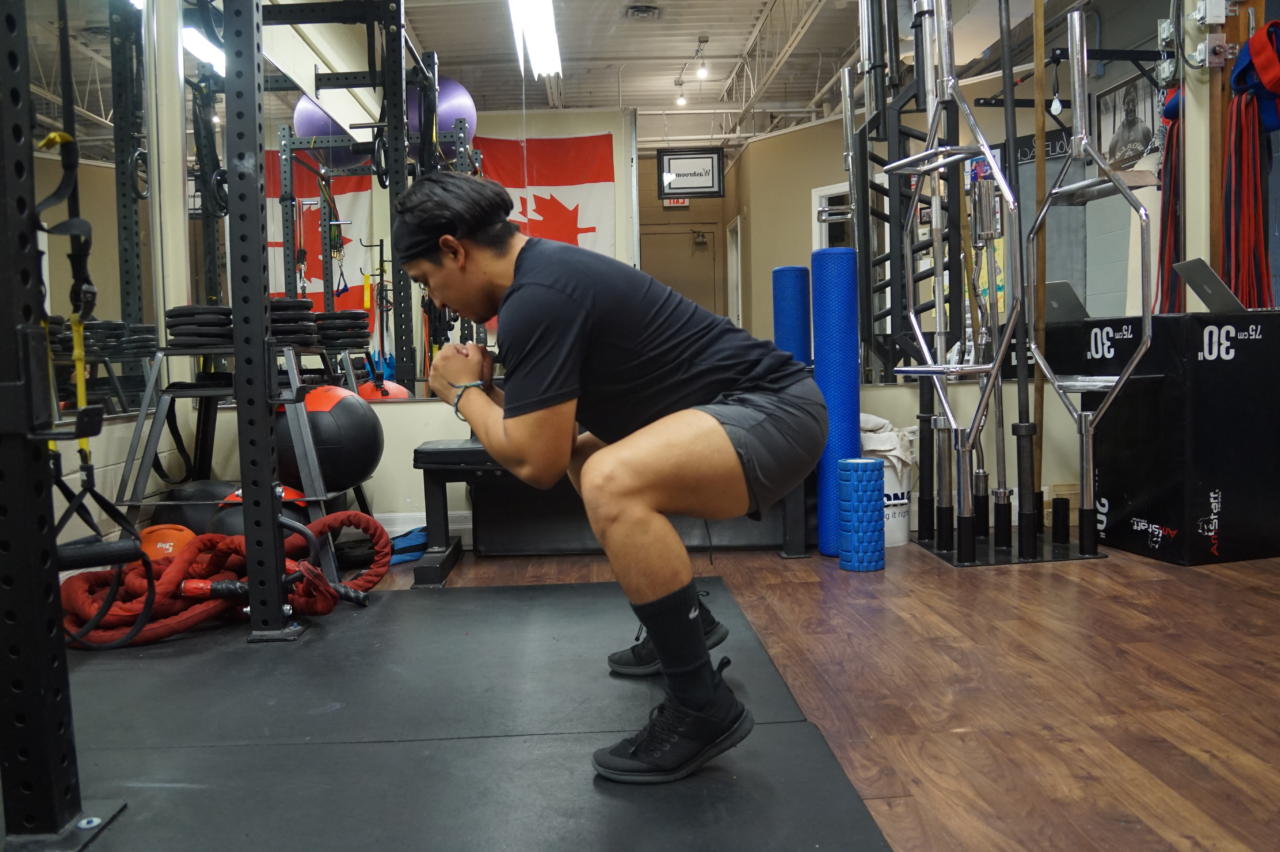
Squatting Too Fast
Squatting too quickly during the ascent or descent, especially when you’re first starting, will lead to faulty squat patterns. Going down too quickly usually leads to hunching of the lower back at the bottom, or the knees collapsing. Squatting too quick during the ascent can lead to hyperextension of the back. Later on, we’ll go over squatting fast but that’s a bit more advanced. When starting off, squat relatively slow (3-4 count going down) and controlled to engage the core and to fully master the movement.
Squatting More Than You Can Handle
This happens at least once every time I go to the YMCA, and probably across gyms worldwide. Person A goes up the to the bar and starts partaking in some quarter squats. He or she finds that it’s too easy so they add 45 lb. plates to each side. They quarter squat again with ankles and knees collapsing. They repeat this cycle 2 or 3 more times and eventually get hurt. Work on getting some proper depth first before moving onto heavier weight. I’m not saying you have to squat ass to grass every time but get some decent depth and form before you trying setting world records.
Squat Variations
Bodyweight Squat
We master the movement with our bodyweight before moving onto loaded and more complex variations. As mentioned above, people have different anatomies and therefore will have different starting stances. Keep the core and upper body tight, and the feet grounded into the floor to generate more force while ascending.
Goblet Squat
A goblet squat consists of holding a kettlebell or dumbbell, like a goblet, in front of you against your sternum. This forces you to engage your core while also counterbalancing you. Adding weight like this tends to clean up the squat pattern and keeps you more balanced. Keep the weight against your sternum throughout the motion and make sure you don’t allow your torso to fall too far forward.
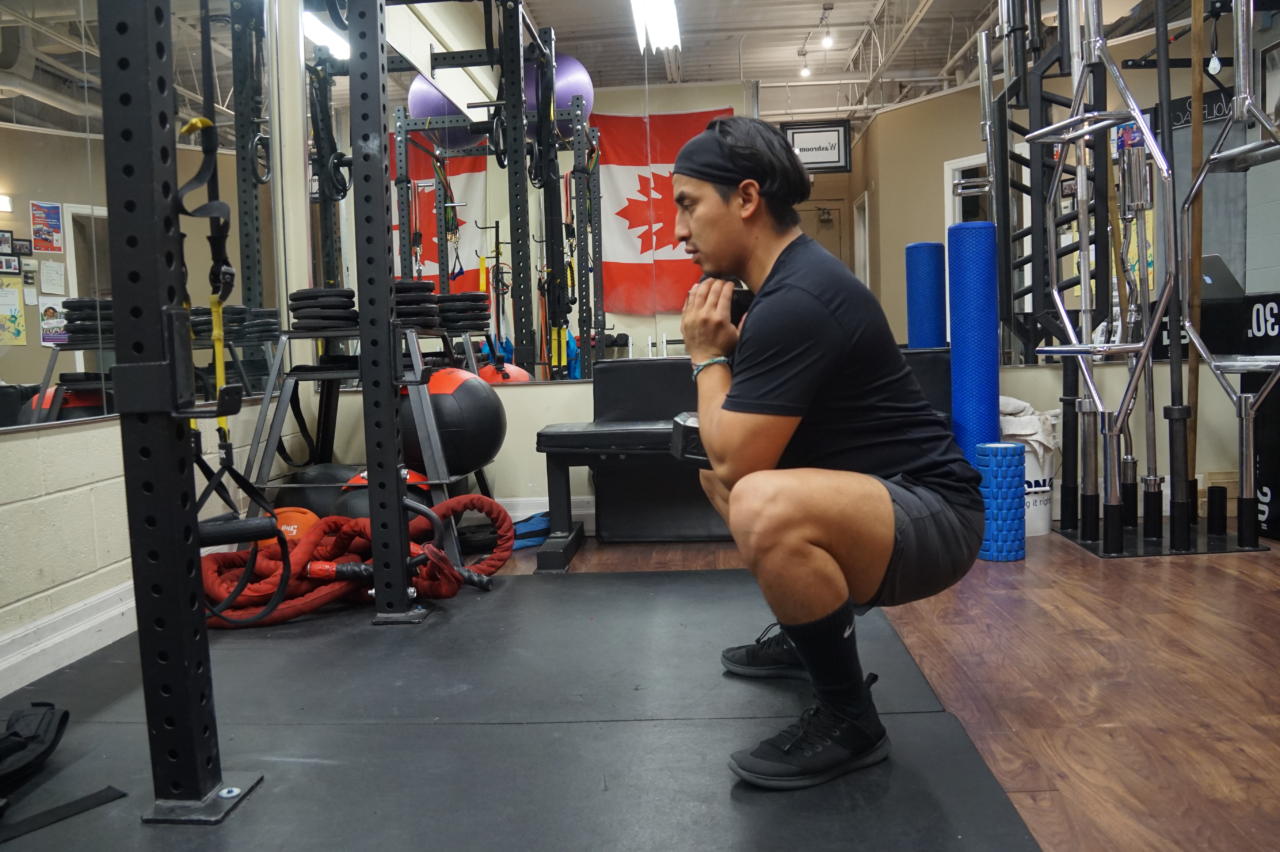
Box Squat
The box squat is commonly used in the powerlifting community, and I also find it is a great beginner squat variation. We don’t sit as far back as the powerlifters when teaching it to new clients but we like using it as it gives people a sense of assurance and proprioception during the descent. It also gets your glutes and hamstrings engaged which is pretty much always a good thing. The box squat does require more of hip hinge to initiate the motion so you will be getting your hips further back. Make sure you don’t plop onto the box at the bottom and don’t worry about rocking back either. Start with your bodyweight before adding a kettlebell or dumbbell (i.e. goblet squat) when doing the box squat.
Landmine squat
The landmine squat forces you to sit back into the hips more and therefore has greater posterior chain recruitment. It also has greater loading potential compared to the goblet squat so a great exercise all around. You can always stick a barbell into a corner at your gym if you don’t have access to a landmine. Here is a great demo going over two landmine squat variations by Ben Bruno.
Barbell Front Squat
The bar is situated in front of you so it forces your core and upper back to work harder as you have to keep an upright body. Zercher squats are also great and deserve an honourable mention here. Back to front squats; the bar is situated on your deltoids and the hands are there more for guidance as opposed to actually holding up the weight.
You can use the front rack grip which gets your fingers under the bar. This grip requires more mobility so it may feel uncomfortable at first, assuming you can get into that position, but it adds greater stability. The crossed arm grip consists of crossing your hands over the bar making an “X”. This position requires less mobility but has less stability. The bar is still on top of your deltoids so make you’re not holding the weight up with your hands. A common mistake is letting your elbows drop when you’re squatting down which puts you in a not so aesthetically pleasing hunched position. Think about driving your elbows up as you squat down. Here’s a great video below from Tony Gentilcore with some front squat tips for the visual people out there:
Barbell Back Squat
This is arguably my favourite exercise and one of the most popular exercises in the world. Like I mentioned earlier in the post, play around and find the stance that works for you and your hip anatomy. Simultaneously break at the hips and knees, and make sure that your hips and knees drive up together as well. You now have a barbell on your upper back so make sure you stay tight on the bar by activating your lats and core. More on that at the end of the blog.
You can use a high bar position which will keep your body more upright and activate your quads more. Or a low bar squat position which will put your torso in a greater inclined angle and will also have greater posterior chain recruitment because of the greater hip drive. I personally like the high bar position, but again play around with it and see what works for you. The low bar position may be better for taller squatters who find their knees shoot forward as soon as they descend.

Single Leg Squat Variations
We’ll go over two of my favourite single leg squat variations that we also use with clients. They’re both great for strength, fat loss, and building muscle. It spares the lower back as you’re not loading your spine so it’s a great option for those that experience back pain or don’t have the shoulder mobility for regular squats.
1. Split Squat
The split squat can be loaded with dumbbells from the front (goblet squat position) or with dumbbells to the side, or a barbell. Drop the hip straight down like an elevator and drive through your front foot as you go up. Common mistakes to watch out for are:
*Using too wide or too narrow of a stance
*Slamming the knee at the bottom
*Knee collapsing inwards
*Losing balance. Tense your upper body!
2. Bulgarian Split Squat (Rear Foot Elevated Split Squats – RFESS)
A very challenging and rewarding exercise! You want to find a good stance and make sure that your front foot isn’t too far forward. The front leg is also the one doing the majority of the work while the back leg stays on the bench. You can either go on the laces or the toes of your back foot as seen below.
The RFESS is more of a vertical hip motion as opposed to a horizontal knee motion so the hip drops up and down like an elevator, similar to the split squat.. This exercise can also be done with a weight vest, barbell, and on a deficit (as seen in the cover picture) to get greater range of motion and therefore more posterior chain recruitment. Also, please note that the guy below is taller so his front foot is further forward.

Bonus Tips To Back Squat More
Tightness
Tension and tightness is everything, especially when you’re trying to squat big. You want to get angry and break the bar. This will allow you to become one with the bar and make the weight feel significantly lighter. You already have 300-400 lb. on your back so everything helps. Get your upper back as tight as possible and then drive the elbows down, which gets your lats engaged. Stiffening your core, and engaging your lats will help your lower back from flexing, as the lats are a lumbar extensor.
Speed and Control
You want to explode when you squat up. Would you rather ascend slowly or quickly when you have 300-400 lb. on your back? It won’t be the fastest motion, of course, but having the mind-set of exploding up will speed up the movement and make the lift go smoother.
So think about gripping the floor with your feet, and really driving your feet into the floor as your squatting up. Do this while you’re crushing the bar as hard as you can. Again, you want it to be controlled and not erratic. This also applies when you’re squatting down. You want to squat down quickly, but with control. A lot is happening here but practice makes perfect.
Conclusion
There is nothing better than a great squatting session, except for maybe a great soccer session. There are so many squat variations out there that I’m sure you can find a variation that works for you and your current fitness levels. Squatting is great for lower body strength especially as we get older, aesthetics, and athletics. Again, find a variation that works for you and don’t force a movement that clearly causes you pain. And here are some lower body exercises you can do at home!
Did you like this article? Follow our social media pages for more content!
Facebook: @RobertoCarlosFitness
Instagram: @RobertoCarlosFitness
YouTube: https://www.youtube.com/channel/UCpfkzmqVVGQJbzRPJ8Kz7fg
